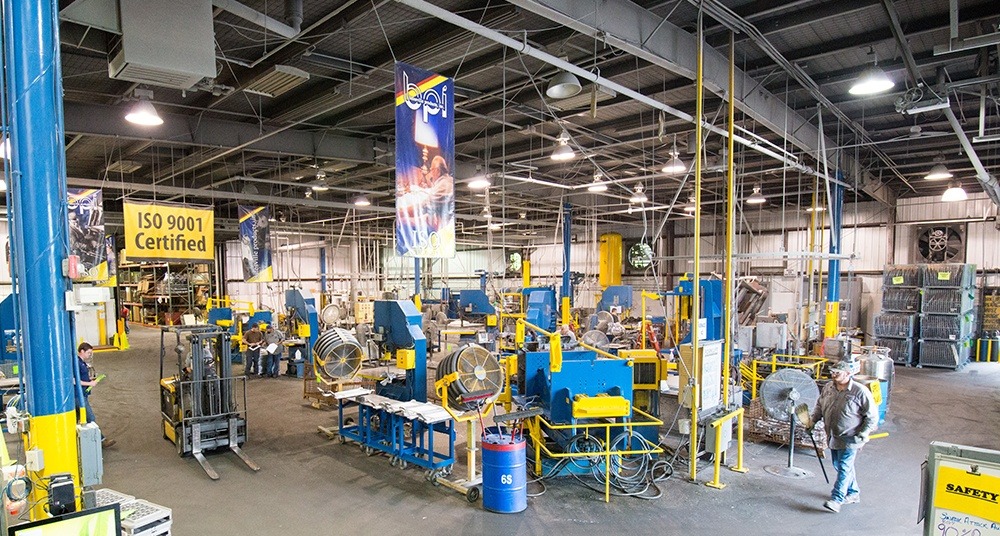When you think of a metalcasting foundry, what picture comes to mind? Maybe a dark plant covered in soot and sweat? Manufacturing facilities, especially foundries, have been stereotyped this way, but like every industry, manufacturing plants evolve over time. Today, USA manufacturing is overflowing with innovation.
In this article, we will bust 5 myths about manufacturing facilities.
Like other modern industries, the manufacturing sector is overflowing with innovation. Advancements in automation and robotics play a key role in today’s manufacturing landscape. At BPI, we use robots to help our employees saw, machine, and polish castings.
Continuous improvement is a motto around here. We constantly strive to improve our efficiencies, quality, and equipment. As technology advances, machinery becomes more available, stronger, smarter, smaller, and faster.

Modern manufacturing facilities are equipped with adequate task lighting. After all, it’s much easier to make a perfect product when you can see what you’re doing! At Batesville Products, our building is covered in windows and garage doors. We like to keep these open for some additional natural light and air flow.
Most manufacturing companies have adopted 6S lean manufacturing practices. This methodology puts an emphasis on organization and cleanliness. 6S stands for…
This involves proper organization and storage of materials and equipment and constant tidying to keep floors and work areas clean.
During sawing, machining, and polishing, you can expect to produce lots of aluminum chips. That’s why we implemented highly advanced venting and collection systems to keep clean. We encourage employees to keep their workspace clean. Between shifts, our employees prioritize sweeping and dusting their work area.

Temperature is a key factor when pouring castings. The mold and metal temperature affect solidification rate as well as work together to affect tool life, fill, porosity, and many other factors.
Since the furnaces, metal, and molds are hot, the environment reflects this heat. To combat this, foundry employees wear breathable clothing and frequently hydrate. Some foundries are even air conditioned!
From an outside perspective, everything looks “highly dangerous” until you learn how to properly perform the task. Just like driving a car, adequate training (like drivers’ education, practicing, and passing your drivers’ test) and proper equipment (like seatbelts, mirrors, and airbags) absolves the element of danger.
When a new employee starts in the foundry, they go through safety training and on-the-job shadowing. They gradually learn how to safely pour molten aluminum, handle hot castings, and use tools.
Proper equipment plays a key role in safety. Employees must wear PPE such as safety glasses, ear plugs, and steel toed boots. Employees are trained to use tools correctly and identify if something is functioning improperly.
When it is hard to distance an employee from equipment that could be used dangerously, we follow strict guidelines and precautions that make the task safe.

If business is conducted without a sustainable mindset, any industry can be harmful to the environment, from fast food to clothing stores. Many manufacturing facilities realize that sustainability leads to profitability. Lean manufacturing is a popular methodology that includes cutting down on raw material consumption, energy usage, and waste.
For foundries, it is easy to cut down on waste. Aluminum is 100% recyclable. Pour a defective casting? Melt it down and try again.
Quite the opposite is true! In fact, many manufacturing companies are currently hiring (apply here). Many open positions offer competitive compensation and benefits packages. And these aren’t just entry level jobs! In reality, manufacturing is a high skilled career. Not everyone can polish castings on their first day.
While there are many job openings in manufacturing, there aren’t many applicants. This is in part due to these 5 stereotypes, which make working in manufacturing seem like a poor career choice.
At BPI, we use robots to empower our employees, not replace them. While some manufacturing facilities were originally built to operate “lights out,” or without people, that’s not the case for most. Robotics are used to assist in a job by working with an operator. Instead of replacing the operator, the operator is redeployed and retraining to perform a less labor-intensive task. For example, instead of loading parts into a machine, they gain the skills to program and oversee a robot that loads parts in a machine.